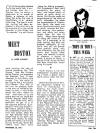
|
MEET BOSTON Friday, November 28, 1941 in What's New In Town W. J. Sidis |
Of all the winding streams in the world, few, if any, are twistier than our own Charles. From its source in Hopkinton to its mouth at Boston, a distance of only about 26 miles the river is nevertheless over seventy miles long. The type of winding, curving has been expressed in old-world by the example of a river called Meander in Asia Minor, and “to meander” is a well-known word covering the idea of twisted wandering. But “Old Quinob,” that the Puritans called Charles, out-meanders the Meander. And, if near Meander in Asia Minor, and ancient Troy, the outlet of the Charles has a far greater City―Boston. One loop of the river, for example, takes in the town of Wellesley between its arms―four miles across the town, twelve by river. And many of us are aware that we can reach the Charles through West Roxbury, past Forest Hills, while downtown we get to it in the opposite direction. Quinobequin―the Long Stream―the Indians called it. Originally composed of several distinct river valleys, when the Ice Age blocked these the stream had to run down one valley then retrace its steps by the next valley, till it found its way to the sea. When the Indians built their weirs (dams for fishing purposes), Old Quinob bent itself wonderfully for plenty of them, and helped plenty of people to settle along its shores. Old Quinob made the acquaintance of the ships of Leif’s Icelanders; he made the acquaintance of Captain John Smith, the same one whom Pocahontas saved; and he gladly received the Puritans escaping from persecution, and slowly but surely taught them the idea of liberty. Many towns sprang up along the twists of the river, till it embraced in its folds nothing less than the greatest metropolis in the world. And still old Quinob flows placidly along, very little affected by the ups and downs that trouble other rivers, and remains a source of pleasure, a source of power, a source of liberty, a source of life, to the millions that have found their haven along his banks.
*
North Station is the only metropolitan building housing a hotel, a depot, and a sports arena under one roof.
*
Before the Revolution, British regulations forbade all forms of manufacture in America, but much undercover work was done along that line in Massachusetts. The Quincy quarries were no exception to that rule, and part of the cover-up was a secret road through the woods to the Neponset River, consisting of two rows of grooved granite bars which could easily be concealed. This was actually the first railroad in the world. The granite bars were later replaced by steel tracks and steam service was put on these tracks. The “Granite Railway” became part of the New Haven Railroad system.